会计学-企业决策的基础
会计学企业决策的基础
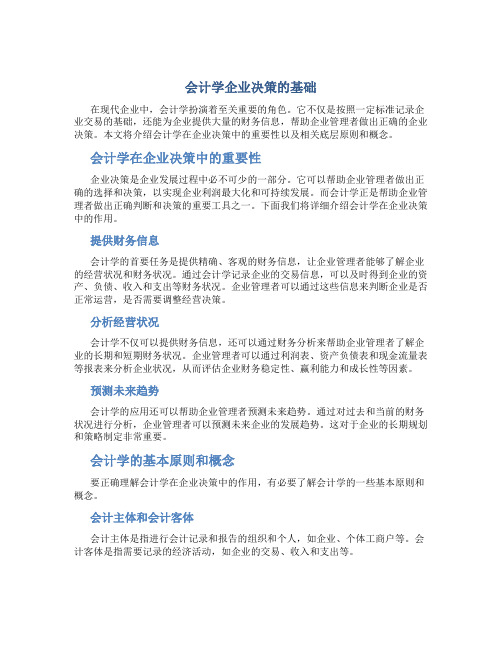
会计学企业决策的基础在现代企业中,会计学扮演着至关重要的角色。
它不仅是按照一定标准记录企业交易的基础,还能为企业提供大量的财务信息,帮助企业管理者做出正确的企业决策。
本文将介绍会计学在企业决策中的重要性以及相关底层原则和概念。
会计学在企业决策中的重要性企业决策是企业发展过程中必不可少的一部分。
它可以帮助企业管理者做出正确的选择和决策,以实现企业利润最大化和可持续发展。
而会计学正是帮助企业管理者做出正确判断和决策的重要工具之一。
下面我们将详细介绍会计学在企业决策中的作用。
提供财务信息会计学的首要任务是提供精确、客观的财务信息,让企业管理者能够了解企业的经营状况和财务状况。
通过会计学记录企业的交易信息,可以及时得到企业的资产、负债、收入和支出等财务状况。
企业管理者可以通过这些信息来判断企业是否正常运营,是否需要调整经营决策。
分析经营状况会计学不仅可以提供财务信息,还可以通过财务分析来帮助企业管理者了解企业的长期和短期财务状况。
企业管理者可以通过利润表、资产负债表和现金流量表等报表来分析企业状况,从而评估企业财务稳定性、赢利能力和成长性等因素。
预测未来趋势会计学的应用还可以帮助企业管理者预测未来趋势。
通过对过去和当前的财务状况进行分析,企业管理者可以预测未来企业的发展趋势。
这对于企业的长期规划和策略制定非常重要。
会计学的基本原则和概念要正确理解会计学在企业决策中的作用,有必要了解会计学的一些基本原则和概念。
会计主体和会计客体会计主体是指进行会计记录和报告的组织和个人,如企业、个体工商户等。
会计客体是指需要记录的经济活动,如企业的交易、收入和支出等。
会计等式会计等式是会计学中的基本概念之一。
它是指资产=负债+所有者权益。
通过这个等式,企业管理者可以了解企业的资产来源和运用情况,包括企业的负债情况和所有者权益。
会计要素会计要素是指企业在经济活动中发生的一系列基本事项。
包括资产、负债、所有者权益、收入和费用等。
会计学 企业决策的基础 财务会计分册 版 章答案

Chapter 6Merchandising Activitie s Ex. 6.41PROBLEM 6.1AClaypool earned a gross profit rate of 32%, which is significantly higher than the industry average. Claypool’s sales were above the industry average, and it earned $77,968 more gross profit than the “average” store of its size. This higher gross profit was earned even though its cost of goods sold was $18,000 to $20,000 higher than the industry average because of the additional transportation charges.To have a higher-than-average cost of goods sold and still earn a much larger-than-average amount of gross profit, Claypool must be able to charge substantially higher sales prices than most hardware stores. Presumably, the company could not charge such prices in a highly competitive environment. Thus, the remote location appears to insulate it from competition and allow it to operate more profitably than hardware stores with nearby competitors.PROBLEM 6.5Ac. Yes. Sole Mates should take advantage of 1/10, n/30 purchase discounts, even if itmust borrow money for a short period of time at an annual rate of 11%. Bytaking advantage of the discount, the company saves 1% by making payment 20 days early. At an interest rate of 11% per year, the bank charges only 0.6%interest over a 20-day period (11% X 20/365 = 0.6%). Thus, the cost of passing up the discount is greater than the cost of short-term borrowing.Chapter 7 Financial assetsChapter 8 Inventories and the cost of goods soldSupplementary ProblemChapter 91617。
会计学企业决策的基础威廉姆斯读后感
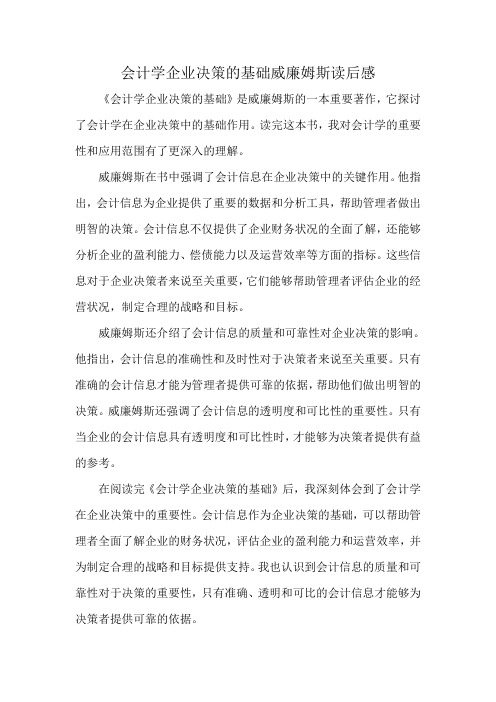
会计学企业决策的基础威廉姆斯读后感《会计学企业决策的基础》是威廉姆斯的一本重要著作,它探讨了会计学在企业决策中的基础作用。
读完这本书,我对会计学的重要性和应用范围有了更深入的理解。
威廉姆斯在书中强调了会计信息在企业决策中的关键作用。
他指出,会计信息为企业提供了重要的数据和分析工具,帮助管理者做出明智的决策。
会计信息不仅提供了企业财务状况的全面了解,还能够分析企业的盈利能力、偿债能力以及运营效率等方面的指标。
这些信息对于企业决策者来说至关重要,它们能够帮助管理者评估企业的经营状况,制定合理的战略和目标。
威廉姆斯还介绍了会计信息的质量和可靠性对企业决策的影响。
他指出,会计信息的准确性和及时性对于决策者来说至关重要。
只有准确的会计信息才能为管理者提供可靠的依据,帮助他们做出明智的决策。
威廉姆斯还强调了会计信息的透明度和可比性的重要性。
只有当企业的会计信息具有透明度和可比性时,才能够为决策者提供有益的参考。
在阅读完《会计学企业决策的基础》后,我深刻体会到了会计学在企业决策中的重要性。
会计信息作为企业决策的基础,可以帮助管理者全面了解企业的财务状况,评估企业的盈利能力和运营效率,并为制定合理的战略和目标提供支持。
我也认识到会计信息的质量和可靠性对于决策的重要性,只有准确、透明和可比的会计信息才能够为决策者提供可靠的依据。
《会计学企业决策的基础》是一本值得深入阅读的书籍。
它为读者提供了更全面的会计学知识,帮助我们认识到会计信息在企业决策中的重要性,并为我们未来在企业决策中提供了宝贵的参考和指导。
会计学企业决策的基础
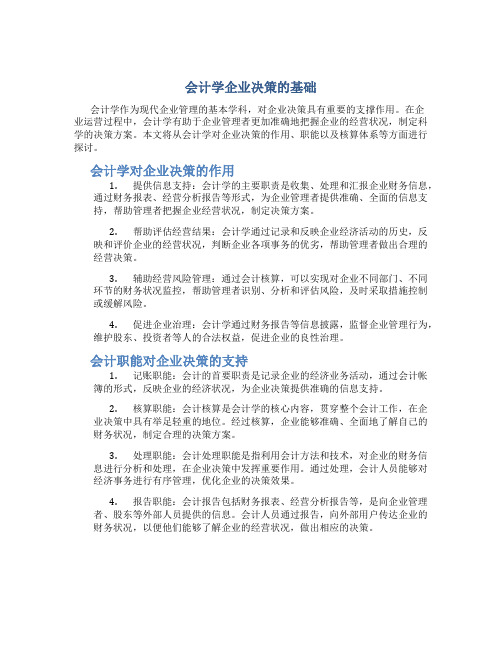
会计学企业决策的基础会计学作为现代企业管理的基本学科,对企业决策具有重要的支撑作用。
在企业运营过程中,会计学有助于企业管理者更加准确地把握企业的经营状况,制定科学的决策方案。
本文将从会计学对企业决策的作用、职能以及核算体系等方面进行探讨。
会计学对企业决策的作用1.提供信息支持:会计学的主要职责是收集、处理和汇报企业财务信息,通过财务报表、经营分析报告等形式,为企业管理者提供准确、全面的信息支持,帮助管理者把握企业经营状况,制定决策方案。
2.帮助评估经营结果:会计学通过记录和反映企业经济活动的历史,反映和评价企业的经营状况,判断企业各项事务的优劣,帮助管理者做出合理的经营决策。
3.辅助经营风险管理:通过会计核算,可以实现对企业不同部门、不同环节的财务状况监控,帮助管理者识别、分析和评估风险,及时采取措施控制或缓解风险。
4.促进企业治理:会计学通过财务报告等信息披露,监督企业管理行为,维护股东、投资者等人的合法权益,促进企业的良性治理。
会计职能对企业决策的支持1.记账职能:会计的首要职责是记录企业的经济业务活动,通过会计帐簿的形式,反映企业的经济状况,为企业决策提供准确的信息支持。
2.核算职能:会计核算是会计学的核心内容,贯穿整个会计工作,在企业决策中具有举足轻重的地位。
经过核算,企业能够准确、全面地了解自己的财务状况,制定合理的决策方案。
3.处理职能:会计处理职能是指利用会计方法和技术,对企业的财务信息进行分析和处理,在企业决策中发挥重要作用。
通过处理,会计人员能够对经济事务进行有序管理,优化企业的决策效果。
4.报告职能:会计报告包括财务报表、经营分析报告等,是向企业管理者、股东等外部人员提供的信息。
会计人员通过报告,向外部用户传达企业的财务状况,以便他们能够了解企业的经营状况,做出相应的决策。
会计核算体系对企业决策的支持1.资产负债表:资产负债表反映企业的资产、负债和所有者权益状况,是企业财务状况的总结表。
会计学企业决策的基础财务会计分册第十七版教学设计

会计学企业决策的基础财务会计分册第十七版教学设计一、教学目标通过本教学,学生将会理解以下内容:•财务会计中的货币和计量论•货币计量法和市场计价法之间的差异•货币计量法和市场计价法之间的转换•不同类型企业的会计核算和报告的区别二、教学内容2.1 财务会计中的货币和计量论1.货币计量原则–货币计量原则是指财务账务应在货币计量基础上进行,并采用货币单位的计量数值作为会计信息记录货币的基本单位。
2.计量原则–计量原则是指会计信息记录应基于以货币单位的计量,计量原则涵盖了会计内容和数量记录标准。
2.2 货币计量法和市场计价法之间的差异•货币计量法和市场计价法是两种不同的计算方法,货币计量法使用货币单位计量资产和负债,而市场计价法通常使用市场实际价格来计算资产和负债。
•市场计价法将更换成本等各种因素都考虑进去,最终得出实际的市场价值,而货币计量法则只考虑以货币单位计价的资产和负债。
2.3 货币计量法和市场计价法之间的转换•转换方法有两种:先将市场计价法的余额转换为货币计量法下的余额,再将货币计量法的余额转换为市场计价法下的余额。
•该转换可以帮助企业管理层在决策时更全面地了解企业的财务情况。
2.4 不同类型企业的会计核算和报告的区别1.非营利组织的会计核算和报告–非营利组织的财务状况与营利组织有所不同,因此他们的会计核算和报告方式也不尽相同。
2.龙头公司的会计核算和报告–龙头公司不仅要满足资本市场的要求,还要考虑到业务的高速成长和竞争对手的变化。
三、教学安排3.1 师生互动讨论•货币计量法和市场计价法的区别,以及转换方法。
•不同类型企业的会计核算和报告的差异。
3.2 理论讲授•通过多种媒介(PPT、视频等)对财务会计中的货币和计量论等内容进行讲解。
3.3 练习•学生根据所学知识完成作业,提高对于财务会计中货币和计量论的掌握程度。
3.4 查考检验•组织考试或者小组和个人项目汇报,以检验学生掌握情况。
四、教学方法本教学将通过以下方式进行:•PPT讲解•视频展现•课堂讨论五、课程评估•考试(占比60%)•小组和个人项目汇报(占比40%)六、教材选择本教学所选教材为《会计学企业决策的基础财务会计分册》第十七版。
会计学企业决策的基础 -回复
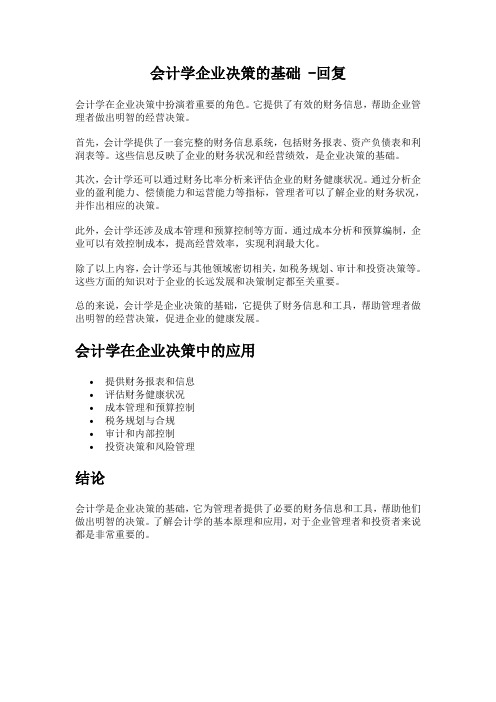
会计学企业决策的基础 -回复
会计学在企业决策中扮演着重要的角色。
它提供了有效的财务信息,帮助企业管理者做出明智的经营决策。
首先,会计学提供了一套完整的财务信息系统,包括财务报表、资产负债表和利润表等。
这些信息反映了企业的财务状况和经营绩效,是企业决策的基础。
其次,会计学还可以通过财务比率分析来评估企业的财务健康状况。
通过分析企业的盈利能力、偿债能力和运营能力等指标,管理者可以了解企业的财务状况,并作出相应的决策。
此外,会计学还涉及成本管理和预算控制等方面。
通过成本分析和预算编制,企业可以有效控制成本,提高经营效率,实现利润最大化。
除了以上内容,会计学还与其他领域密切相关,如税务规划、审计和投资决策等。
这些方面的知识对于企业的长远发展和决策制定都至关重要。
总的来说,会计学是企业决策的基础,它提供了财务信息和工具,帮助管理者做出明智的经营决策,促进企业的健康发展。
会计学在企业决策中的应用
•提供财务报表和信息
•评估财务健康状况
•成本管理和预算控制
•税务规划与合规
•审计和内部控制
•投资决策和风险管理
结论
会计学是企业决策的基础,它为管理者提供了必要的财务信息和工具,帮助他们做出明智的决策。
了解会计学的基本原理和应用,对于企业管理者和投资者来说都是非常重要的。
《会计学企业决策的基础》
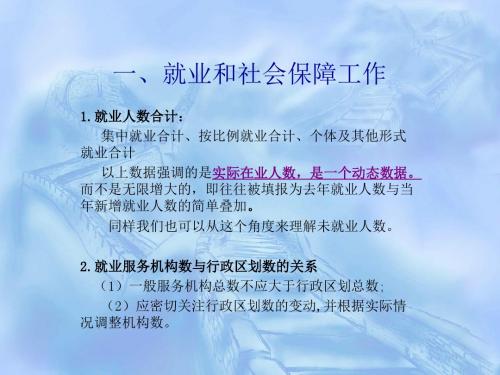
(二)高中阶段
1.特殊教育普通高中: 经县级以上教育行政部门批准,专门招收盲、聋初 中毕业生实施普通高中教育的学校(班)的实际达到数。 2.残收含(中职、 中专、中技、成人中专、职高等)的学校(班)的实际 达到数。
3. 获得职业资格证书人数: 毕业学生中通过国家职业资格考试,获得职业资格 证书。
3. 中央下拨资金的数量和任务数(比如危房中的中央 资金,还有农村实用技术培训的补助资金),都要 严格按中央下达数字准确填写。
一、就业和社会保障工作
1.就业人数合计: 集中就业合计、按比例就业合计、个体及其他形式 就业合计 以上数据强调的是实际在业人数,是一个动态数据。 而不是无限增大的,即往往被填报为去年就业人数与当 年新增就业人数的简单叠加。 同样我们也可以从这个角度来理解未就业人数。 2.就业服务机构数与行政区划数的关系 (1)一般服务机构总数不应大于行政区划总数; (2)应密切关注行政区划数的变动,并根据实际情 况调整机构数。
(三)高等教育
高等教育特殊教育学院: 指经过教育行政部门批准举办的,通过单独考试, 单独招收高中毕业文化程度的盲、聋学生实施高等教育 的学院(系、专业、班)。 此外,本栏下的录取人数是本年度录取数。
三、扶贫工作
1.认真仔细阅读指标说明,对每一项指标的内涵要理解, 明白是什么意思 ,最起码知道这个数到底应该有 多少的一个范围。 2.有些指标在指标说明明显注明有逻辑关系的,填报后 自己算一算,比较一下,是不是符合逻辑。
就业 -托养服务机构
1.机构性质: 民办非企业、事业单位 其他: 2. 托养残疾人数: 智力、精神残疾人数 其他类别残疾人数 3. 重度残疾人: 智力、精神、其他类别中属于重度残疾人的人数。
二、残疾人教育工作
会计学-企业决策的基础 答案教学资料

会计学-企业决策的基础答案管理会计作业(chapter16-20)Chapter 16 P757 16.5AChapter 16 P761 16.4BChapter 17 P802 17.3Aa. Department One overhead application rate based on machine-hours:Manufacturing Overhead= $420,000= $35 per machine-hourMachine-Hours 12,000Department Two overhead application rate based on direct labor hours:Manufacturing Overhead= $337,500= $22.50 per direct labor hourDirect Labor Hours 15,000Chapter 17 P805 17.8Ad. The Custom Cuts product line is very labor intensive in comparison to the BasicChunks product line. Thus, the company’s current practice of using direct laborhours to allocate overhead results in the assignment of a disproportionate amount of total overhead to the Custom Cuts product line. If pricing decisions are set as a fixed percentage above the manufacturing costs assigned to each product, the Custom Cuts product line is overpriced in the marketplace whereas the Basic Chunks product line is currently priced at an artificially low price in the marketplace. This probablyexplains why sales of Basic Chunks remain strong while sales of Custom Cuts are on the decline.e. The benefits the company would achieve by implementing an activity-based costingsystem include: (1) a better identification of its operating inefficiencies, (2) a betterunderstanding of its overhead cost structure, (3) a better understanding of theresource requirements of each product line, (4) the potential to increase the sellingprice of Basic Chunks to make it more comparable to competitive brands and possibly do so without having to sacrifice significant market share, and (5) the ability todecrease the selling price of Custom Cuts without having to sacrifice product quality.Chapter 18 P835 18.1a. job costing (each project of a construction company is unique)B. Ex.18.1b. both job and process costing (institutional clients may represent uniquejobs)c. job costing (each set of equipment is uniquely designed andmanufactured)d. process costing (the dog houses are uniformly manufactured in highvolumes)e. process costing (the vitamins and supplements are uniformlymanufactured in high volumes)Chapter 18 P841 18.3Ab4,000 EU @ $13.50 = $54,000Chapter 18 P845 18.2Ba. (1) $49 [($192,000 + $48,000 + $54,000) ÷ 6,000 units](2) $109 [($480,000 + $108,000 + $66,000) ÷ 6,000 units](3) $158 ($49 + $109)(4) $32 ($192,000 ÷ 6,000 units)(5) $18 ($108,000 ÷ 6,000 units)b. In evaluating the overall efficiency of the Engine Department, management wouldlook at the monthly per-unit cost incurred by that department, which is the cost of assembling and installing an engine ($109 in part a).Chapter 20 P918 20.1Ad. No. With a unit sales price of $94, the break-even sales volume in units is 54,000 units:Unit contribution margin = $94 - $84 variable costs = $10Break-even sales volume (in units) = $540,000$10= 54,000 unitsUnless Thermal Tent has the ability to manufacture 54,000 units (or lower fixed and/or variable costs), setting the unit sales price at $94 will not enable Thermal Tent to break even.Chapter 20 P918 20.2AChapter 20 P920 20.6ASales volume required to maintain current operating income:Sales Volume =Fixed Costs + Target Operating IncomeUnit Contribution Margin=$390,000 + $350,000= $20,000 units$37。
会计学企业决策的基础财务会计分册第17版
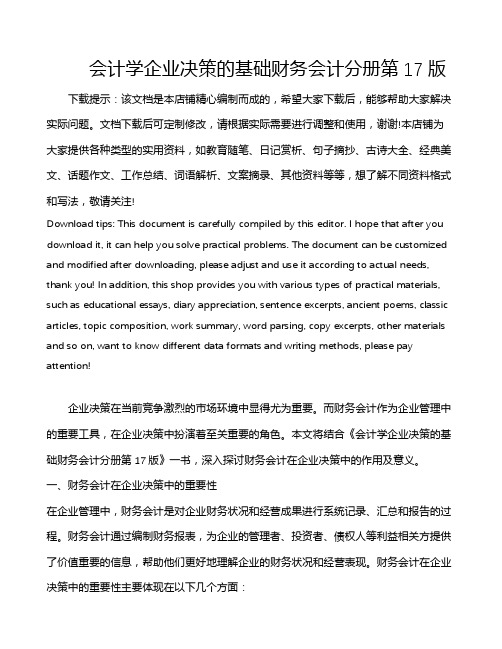
会计学企业决策的基础财务会计分册第17版下载提示:该文档是本店铺精心编制而成的,希望大家下载后,能够帮助大家解决实际问题。
文档下载后可定制修改,请根据实际需要进行调整和使用,谢谢!本店铺为大家提供各种类型的实用资料,如教育随笔、日记赏析、句子摘抄、古诗大全、经典美文、话题作文、工作总结、词语解析、文案摘录、其他资料等等,想了解不同资料格式和写法,敬请关注!Download tips: This document is carefully compiled by this editor. I hope that after you download it, it can help you solve practical problems. The document can be customized and modified after downloading, please adjust and use it according to actual needs, thank you! In addition, this shop provides you with various types of practical materials, such as educational essays, diary appreciation, sentence excerpts, ancient poems, classic articles, topic composition, work summary, word parsing, copy excerpts, other materials and so on, want to know different data formats and writing methods, please pay attention!企业决策在当前竞争激烈的市场环境中显得尤为重要。
会计学企业决策的基础 课后习题 答案 chapter
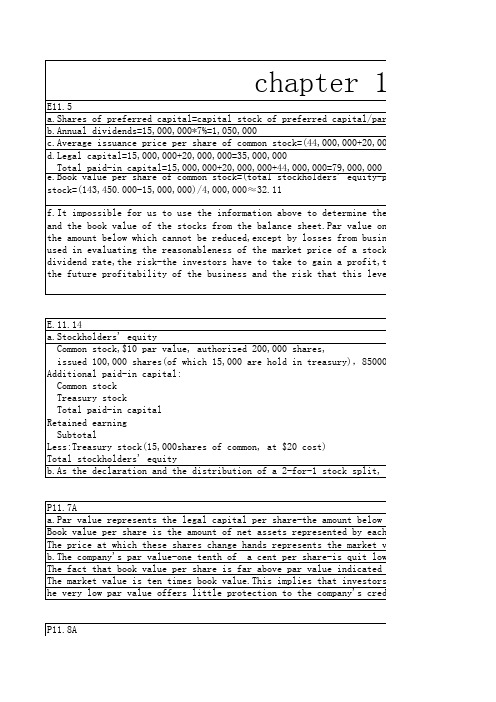
Total paid-in capital=15,000,000+20,000,000+44,000,000=79,000,000 e.Book value per share of common stock=(total stockholders' equity-preferred stock)/shares stock=(143,450.000-15,000,000)/4,000,000≈32.11
会计学:企业决策的基础财务会计分册(机械工业出版社,英文原书第15版)课后练习答案chapter05

Exercises 5.1 5.2 5.3 5.4 5.5 5.6 5.7 5.8 5.9 5.10 5.11 5.12 5.13 5.14 5.15
Topic Accounting terminology Financial statement preparation Financial statement preparation Closing and after-closing trial balance Closing and after-closing trial balance Real World: Circuit City Adequate Disclosure Closing entries of profitable firms Closing entries of unprofitable firms Adjusting versus closing entries Profitability and liquidity measures Profitability and liquidity measures Interim results Interim results Effects of accounting errors Real World: Home Depot, Inc. Using an annual report
Communication, analysis
© The McGraw-Hill Companies, Inc., 2008 Overview
© The McGraw-Hill Companies, Inc., 2008 Overview
CHAPTER 5 THE ACCOUNTING CYCLE: REPORTING FINANCIAL RESULTS
会计学企业决策的基础《会计学企业决策的基础》

§ 负债(Liabilities)是由过去的交易、事项形 成的现有义务,履行该义务预期会导致经济 利益流出企业。
§ 负债的特征是:
§ (1)负债是由于过去的交易或事项所引起的企 业的现有义务。企业预期在将来要发生的交 易或事项可能产生的债务,不能作为会计上 的负债处理;
PPT文档演模板
会计学企业决策的基础《会计学企业 决策的基础》
PPT文档演模板
•成本和收入决定: • 分批成本法 • 分步成本法 • 作业成本法 •销售:收入和利润 •资产和负债 •厂房和设备 •贷款和资产 •应收和应付款项 •现金和存款 •现金流: • 经营活动现金流 • 筹资活动现金流 • 投资活动现金流
•决策支持 •本-量-利分析 •业绩评估 •增值分析 •预算 •资本分配 •每投收益 •比率分析
会计学企业决策的基础《会计学企业 决策的基础》
三、所有者权益
§所有者权益(owner‘s equity),是所有者在企 业资产中享有的经济利益,其金额为资产减 去负债后的余额。它表明企业的资产总额在 抵偿了现存的一切债务后的差额,所有者享 有的份额。
§ 所有者权益就其形成看,除投入资本与资本 公积外,主要来源于企业的经营积累。
会计行为可分为三类:
§ (一)会计核算行为 § 即以货币为主要的计量单位,采用专门方法,
通过计量、计算、记录、分类、汇总等程序, 对单位的经济活动进行连续、系统、完整的 反映,以提供会计信息的活动。
PPT文档演模板
会计学企业决策的基础《会计学企业 决策的基础》
(二)会计监督行为
§ 即从单位内部和外部对单位会计核算本身, 以及纳入经济核算范围之内的经济业务事项 进行监督的活动。
公布等,特别是对其中的会计信息进行监督,以防 欺骗投资人。 § (4)财税部门——对纳税额的监督核实。 § (5)工会、职工、社会公众、专业分析师等。
会计学-企业决策的基础-14版-PPT01
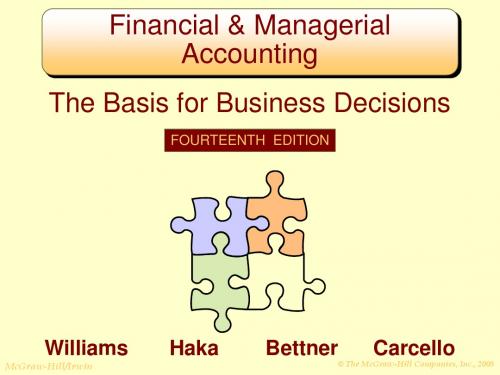
Based on General-Purpose Assumption Results from Inexact and Approximate Measures
McGraw-Hill/Irwin
Historical in Nature
© The McGraw-Hill Companies, Inc., 2008
McGraw-Hill/Irwin
Financial Information Provided Profitability Financial position Cash flows
Decisions Supported Performance evaluations Stock investments Tax strategies Labor relations Resource allocations Lending decisions Borrowing
LO2
McGraw-Hill/Irwin
© The McGraw-Hill Companies, Inc., 2008
Accounting Systems
An accounting system consists of the personnel, procedures, technology, and records used by an organization to develop accounting information and to communicate this information to decision makers.
© The McGraw-Hill Companies, Inc., 2008
Basic Functions of an Accounting System
会计学-企业决策的基础 答案
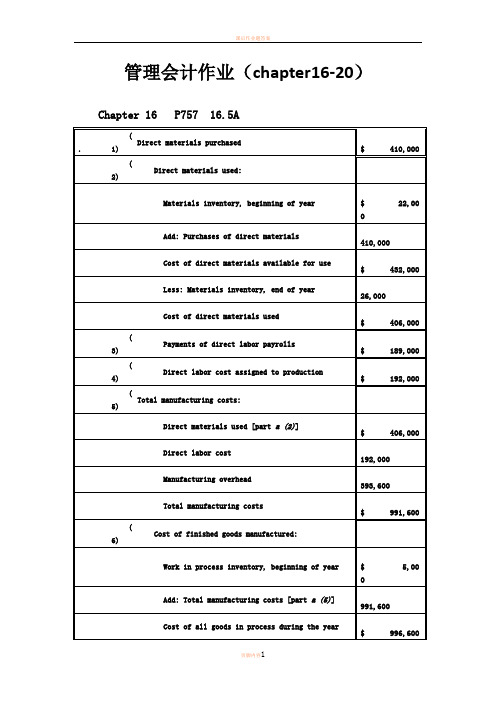
管理会计作业(chapter16-20)Chapter 16 P757 16.5AChapter 16 P761 16.4BChapter 17 P802 17.3Aa.Department One overhead application ratebased on machine-hours:Manufacturing Overhead$420,000=$35 per machine-hourMachine-Hours 12,00 0Department Two overhead application rate based on direct labor hours:Manufacturing Overhead$337,500=$22.50 per direct laborhourDirect Labor Hours 15,00 0Chapter 17 P805 17.8Ad .The Custom Cuts product line is very labor intensive in comparison to theBasic Chunks product line. Thus, the company’s current practice of using direct labor hours to allocate overhead results in the assignment of a disproportionate amount of total overhead to the Custom Cuts product line. If pricing decisions are set as a fixed percentage above the manufacturing costs assigned to each product, the Custom Cuts product line is overpriced in the marketplace whereas the Basic Chunks product line is currently priced at an artificially low price in the marketplace. This probably explains why sales of Basic Chunks remain strong while sales of Custom Cuts are on the decline.e .The benefits the company would achieve by implementing an activity-basedcosting system include: (1) a better identification of its operating inefficiencies, (2) a better understanding of its overhead cost structure, (3) a better understanding of the resource requirements of each product line, (4) the potential to increase the selling price of Basic Chunks to make it more comparable to competitive brands and possibly do so without having to sacrifice significant market share, and (5) the ability to decrease the selling price of Custom Cuts without having to sacrifice product quality.Chapter 18 P835 18.1B. Ex. 18.1a.job costing (each project of a construction company is unique)b.both job and process costing (institutional clients may represent unique jobs)c.job costing (each set of equipment is uniquely designed and manufactured)d.process costing (the dog houses are uniformly manufactured in high volumes)e.process costing (the vitamins and supplements are uniformly manufactured in high volumes)Chapter 18 P841 18.3AInputs:•Beginning WIP•StartedOutputs:•Units completed•Ending WIP•Beginning WIP•Units started•Units completed•Ending WIP•Cost of beginning WIP•Cost added during the period•Cost of goods transferredtransferred•Add ending WIP$246,000b4,000 EU @ $13.50 =$54,000Chapter 18 P845 18.2Ba .(1)$49 [($192,000 + $48,000 + $54,000) ÷ 6,000 units](2)$109 [($480,000 + $108,000 + $66,000) ÷6,000 units] (3)$158 ($49 + $109)(4)$32 ($192,000 ÷ 6,000 units)(5)$18 ($108,000 ÷ 6,000 units)b .In evaluating the overall efficiency of the Engine Department, managementwould look at the monthly per-unit cost incurred by that department, which is the cost of assembling and installing an engine ($109 in part a).Chapter 20 P918 20.1Ad .No. With a unit sales price of $94, the break-even sales volume in unitsis 54,000 units:Unit contribution margin = $94 - $84 variable costs = $10Break-even sales volume (in units)$540,000$1054,000 unitsUnless Thermal Tent has the ability to manufacture 54,000 units (or lower fixed and/or variable costs), setting the unit sales price at $94 will not enable Thermal Tent to break even.Chapter 20 P918 20.2AChapter 20 P920 20.6ASales volume required to maintain current operating income:Sales VolumeFixed Costs + TargetOperating IncomeUnit Contribution Margin$390,000 + $350,000= $20,000 units $37。
会计学-企业决策的基础 答案
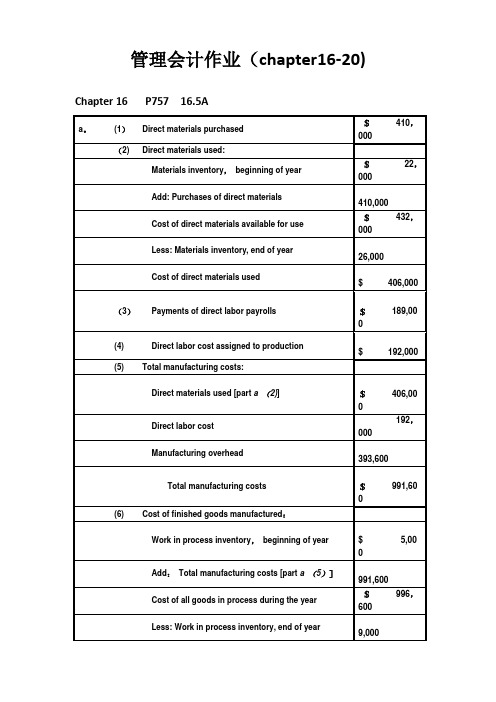
管理会计作业(chapter16-20) Chapter 16 P757 16.5AChapter 16 P761 16。
4BChapter 17 P802 17.3Aa. Department One overhead application rate based onmachine-hours:ManufacturingOverhead = $420,000 = $35 per machine-hourMachine—Hours 12,000Department Two overhead application rate based on direct labor hours:ManufacturingOverhead = $337,500 = $22.50 per direct labor hour Direct Labor Hours 15,000Chapter 17 P805 17.8Ad. The Custom Cuts product line is very labor intensive in comparison to the Basic Chunksproduct line. Thus,the company’s current practice of using direct labor hours toallocate overhead results in the assignment of a disproportionate amount of totaloverhead to the Custom Cuts product line。
If pricing decisions are set as a fixedpercentage above the manufacturing costs assigned to each product, the Custom Cutsproduct line is overpriced in the marketplace whereas the Basic Chunks product line is currently priced at an artificially low price in the marketplace。
会计学:企业决策的基础

20 COST-VOLUME-PROFIT ANALYSISChapter SummaryThe relationship between costs and revenue and the level of business activity is the foundation of profit planning. We begin our presentation of cost-volume-profit analysis with an introduction to cost behavior relationships. Fixed, variable and semivariable cost functions are illustrated graphically and numerically. The distinction between the behavior of total and unit costs is explained and graphically illustrated as well.With the various cost behavior patterns established, the chapter turns to the development of the basic CVP model. This analysis is initially presented graphically. Following discussion of the contribution margin concept the same results are established numerically. The model is solved for target levels of operating income and the margin of safety. A number of comparative static experiments illustrate the usefulness of the CVP model in a realistic planning situation. This example is developed from the point of view of managers of several different functional areas.The chapter concludes with an examination of the significance of sales mix and the high-low method of estimating fixed and variable components of mixed costs. Learning Objectives1.Explain how fixed, variable, and semivariable costs respond to changes in the volumeof business activity.2.Explain how economies of scale can reduce unit costs.3.Prepare a cost-volume-profit graph.pute contribution margin and explain its usefulness.5.Determine the sales volume required to earn a desired level of operating income.e the contribution margin ratio to estimate the change in operating income causedby a change in sales volume.e CVP relationships to evaluate a new marketing strategy.e CVP when a company sells multiple products.9.Determine semivariable cost elements.Brief topical outlineA Cost-volume relationships1Fixed costs (and fixed expenses)2Variable costs (and variable expenses)3Semivariable costs (and semivariable expenses) - see Case in Point(page 883)4 Cost-volume relationships: a graphic analysis5The behavior of per-unit costs - see Your Turn (page 886)6Economies of scale - see Case in Point (page 886)7Additional cost behavior patternsB Cost behavior and operating income1Cost-volume-profit analysis: an illustration2 Preparing and using a cost-volume-profit graph3Contribution margin: a key relationshipa Contribution margin ratio4How many units must we sell?5How many dollars in sales must we generate?6What is our margin of safety?7What change in operating income do we anticipate?8Business applications of CVPa Director of advertisingb Plant manager - see Your Turn (page 894)c Vice president of sales9Additional considerations in CVP10CVP analysis when a company sells many productsa Improving the "quality" of the sales mix11Determining semivariable cost elements: the high-low method12Assumptions underlying cost-volume-profit relationships13Summary of basic cost-volume-profit relationships – see Ethics, Fraud & Corporate Governance (page 898)C Concluding remarksTopical coverage and suggested assignmentComments and observationsTeaching objectives for Chapter 20In this chapter, we explain the patterns of cost behavior and cost-volume-profit relationships. In discussing cost behavior patterns and cost-volume-profit analysis, our teaching objectives are to:1Explain the importance of understanding cost-volume-profit relationships in planning and controlling business operations.2Define and provide examples of fixed costs, variable costs, and semivariable costs.3Contrast the behavior of a cost expressed on per-unit basis with that of the total cost.4Explain that cost behavior patterns (and cost-volume-profit analysis) serve only as useful approximations. (As part of this discussion, explore other cost behaviorpatterns and introduce the concept of the relevant volume range.)5 Illustrate the preparation of a break-even graph, and explain its usefulness.6Define contribution margin, contribution margin ratio,and contribution margin per unit. (Stress that these concepts form the cornerstone of cost-volume-profitanalysis, and also will be used extensively in later chapters.)7Show how contribution margin ratio and/or contribution margin per unit are used to determine the sales volume necessary to earn a specified level of operating income.8Illustrate the importance of sales mix and the relative contribution margin ratios of different products.9Illustrate and explain the high-low method of determining the fixed and variable components of a semivariable cost.10Review the assumptions underlying cost-volume-profit analysis.11Review the summary of basic cost-volume-profit relationships.General commentsWe find that the challenge in successfully presenting cost-volume-profit analysis is to get students to understand the significance of contribution margin, rather than to commit numerous formulas to memory. Memorizing formulas serves little purpose beyond the next exam; an understanding of the concept of contribution margin, however, can serve students well through a lifetime of managerial and personal financial decisions.Contribution margin is merely that portion of revenue that "contributes" to fixed costs and (after covering the fixed costs) to operating income. In short, all revenue except for the contribution margin is consumed by the variable costs relating to the revenue. Once students grasp the fact that only the contribution margin "contributes" to covering fixed costs and to providing a profit, most of the formulas presented in this chapter will "fall into place."We recommend that in approaching any cost-volume-profit problem (homework assignment or exam question), students jot down in the margin of the paper the contribution margin ratio and contribution margin per unit. One of these measurements is usually the key to solving the problem.Supplemental ExercisesGroup ExerciseSuppose a company faces two technologies for manufacturing its single product. The first requires significantly higher fixed costs but much smaller unit variable costs than does the second. Prepare a cost-volume-profit graph for each of the technologies. Using the graphs, discuss the economic circumstances that would lead to a choice of one technology over the other.Internet ExerciseResearch the Dell Computer website at /and the Hewlett Packard website at / to see how these corporations differ in their approach to manufacturing and selling personal computers.10-MINUTE QUIZ A SECTIONInformation regarding a product manufactured and sold by Schiffman is shown below:Maximum capacity with existing facilities 4,000 unitsTotal fixed costs per month ......................................................................... $50,000Variable cost per unit ................................................................................... $42.00Sales price per unit ....................................................................................... $56.001Refer to the above data. The contribution margin ratio for this product is:a20%.c30%.b25%.d40%.2Refer to the above data. The number of units Schiffman must sell to break even is: (rounded)a3,927.c4,823.b3572. d5,140.3Refer to the above data. The dollar sales volume necessary to produce monthly operating income of $12,000 before taxes is:a$188,000.c$288,000.b$186,000.d$248,000.Use the following data for questions 4 and 5.The monthly high and low levels of units and total manufacturing overhead for RatnereCompany are shown below:ManufacturingUnits Overhead Highest observed level .................................................... 117,000 $306,000Lowest observed level .................................................... 81,000 234,0004Refer to the above data. The cost formula for Ratnere’s monthly overhead cost can be expressed as:a$2.65 average cost per unit.b$1.75 average cost per unit.c$24,000 fixed cost plus $1.00 per unit.d$72,000 fixed cost + $2.00 per unit.5Refer to the above data.In a month in which 30,000 equivalent full units are produced, Ratnere’s manufacturing overhead should be approximately:a $52,500.c$ 132,000.b$79,500.d$ 90,500.10-MINUTE QUIZ B SECTION1Management predicts total sales for June to be $3,000,000, yielding a margin of safety of $1,000,000 and a contribution margin ratio of 25%. Which of thefollowing amounts is not consistent with this information?a Fixed costs, $500,000.b Variable costs, $750,000.c Operating income, $250,000.d Break-even sales volume, $2,000,000.Use the following data for questions 2 through 4.The recent high and low levels of hours operated and monthly repair cost for heavy equipment for Universal Mfg. are shown below:Hours Operated Repair Cost Highest observed level 24,000 $7,450Lowest observed level .................................................... 21,500 6,7002Refer to the above data. Using the high-low method, compute the variable element of repair cost per hour of operation for Universal’s equipment:a $750c$0.30.b$3.33.d$0.34.3Refer to the above data. Using the high-low method, compute the fixed element of Universal’s monthly repair cost:a $150.c$6,300.b$250.d$6,450.4Refer to the above data.The total estimated repair cost for a month in which Universal operates equipment for 19,000 hours is:a$5,950.c$6,450.b$6,300.d$5,700.5Perkins Corporation manufactures two products; data are shown below:Contribution RelativeMargin Ratio Sales Mix Product A ........................................................................ 40% 40%Product B......................................................................... 30% 60%If Perkins’ monthly fixed costs average $425,000, what is its break-even pointexpressed in sales dollars?a$1,320,000.c$1,250,000.b$1,400,000.d$990,000.CHAPTER 20 NAME _____________________#10-MINUTE QUIZ C SECTIONPaulsen Company sells only one product. The regular selling price is $50. Variable costs are 70% of this selling price, and fixed costs are $7,500 per month.Management decides to increase the selling price from $50 to $55 per unit. Assume that the cost of the product and the fixed operating expenses are not changed by this pricing decision. 1Refer to the above data. At the original selling price of $50 per unit, what is the contribution margin ratio?2Refer to the above data. At the original selling price of $50 per unit, how many units must Paulsen sell to break even?3Refer to the above data. At the original selling price of $50 per unit, what dollar volume of sales per month is required for Paulsen to earn a monthly operating income of $5,000?4Refer to the above data.At the increased selling price of $55 per unit, what is the contribution margin ratio?5Refer to the above data. At the increased selling price of $55 per unit, what dollar volume of sales per month is required to break-even?CHAPTER 20 NAME #10-MINUTE QUIZ D SECTIONRhinefold brews reduced calorie beer and regular beer. Sales of its reduced calorie beer represent 25% of the company’s total revenue. Sales of regular beer represent the remaining 75%. Reduced calorie beer has a contribution margin ratio of 80%, whereas the contribution margin ratio of regular beer is only 60%. Rhinefold’s monthly fixed costs average $609,500. 1What is the company’s monthly break-even point expressed in sales dollars? $__________2What monthly sales level must be achieved for Rhinefold to earn a monthly operating income of $350,000? $__________3If Rhinefold generates $1,400,000 in monthly sales, it will earn a monthly operating income of $__________.4Assume Rhine fold’s margin of safety was $300,000 in May. What was the company’s operating income in May? $__________.5If Rhinefold’s monthly fixed costs increase by $8,500, what level of monthly sales revenue will be required to break-even? $__________.SOLUTIONS TO CHAPTER 20 10-MINUTE QUIZZESQUIZ A QUIZ B1B1 B2B2 C3D3 B4D4 A5C5 CLearning Learning Objectives: 1, 4, 5, 6, 8, 9 Objectives: 4, 5, 6QUIZ C1Sales price (100%) minus variable costs (70%) = 30%2Sales volume (units) = fixed costs / contribution margin$7,500 / ($50 x 30%) = 500 units3fixed costs + operating incomeSales volume (dollars) = ___________________________contribution margin ratio$7,500 + $5,000= ______________ = $41,66730%4$55 sales price - $35 variable cost per unit ($50 x 70%)___________________________________________________ = 36.4%$55 sales price5Sales volume (dollars) = fixed costs / contribution margin ratio= $7,500 / 30% = $25,000Learning Objective: 7QUIZ D1$609,500/[(75% x 60%) + (25% x 80%)] = $937,6922($609,500 + $350,000)/[75% x 60%) + (25% x 80%)] = $1,476,154 3$1,400,000 x [(75% x 60%) + $1,400,000 (25% x 80%)] = $910,000; Thus, operating income = $910,000 - $609,500 = $300,5004$300,000 x [(75% x 60%) + (25% x 80%)] = $195,0005($609,500 + $8,500)/[(75% x 60%) + (25% x 80%)] = $950,769 Learning Objective: 4, 5, 6, 8Chapter 20 - Cost-Volume-Profit AnalysisAssignment Guide to Chapter 20Financial and Managerial Accounting, 17/e 20-11 Copyright © 2015 McGraw-Hill Education. All rights reserved. No reproduction or distribution without the prior written consent of McGraw-Hill Education.。
- 1、下载文档前请自行甄别文档内容的完整性,平台不提供额外的编辑、内容补充、找答案等附加服务。
- 2、"仅部分预览"的文档,不可在线预览部分如存在完整性等问题,可反馈申请退款(可完整预览的文档不适用该条件!)。
- 3、如文档侵犯您的权益,请联系客服反馈,我们会尽快为您处理(人工客服工作时间:9:00-18:30)。
管理会计作业(chapter16-20)Chapter 16 P757 16.5A
Chapter 16 P761 16.4B
Chapter 17 P802 17.3A
a. Department One overhead application rate based on
machine-hours:
Manufacturing
Overhead = $420,000 = $35 per machine-hour Machine-Hours 12,000
Department Two overhead application rate based on direct labor hours:
Manufacturing
Overhead = $337,500 = $22.50 per direct labor hour
Direct Labor Hours 15,000
Chapter 17 P805 17.8A
d. The Custom Cuts product line is very labor intensive in comparison to the Basic Chunks
product line. Thus, the company’s current practice of using direct labor hours to
allocate overhead results in the assignment of a disproportionate amount of total overhead to the Custom Cuts product line. If pricing decisions are set as a fixed percentage above the manufacturing costs assigned to each product, the Custom Cuts product line is
overpriced in the marketplace whereas the Basic Chunks product line is currently priced at an artificially low price in the marketplace. This probably explains why sales of Basic Chunks remain strong while sales of Custom Cuts are on the decline.
e. The benefits the company would achieve by implementing an activity-based costing system
include: (1) a better identification of its operating inefficiencies, (2) a better understanding of its overhead cost structure, (3) a better understanding of the resource requirements of each product line, (4) the potential to increase the selling price of Basic Chunks to make it more comparable to competitive brands and possibly do so without having to sacrifice
significant market share, and (5) the ability to decrease the selling price of Custom Cuts without having to sacrifice product quality.
Chapter 18 P835 18.1
B. Ex.
18.1
a. job costing (each project of a construction company is unique)
b . both job and process costing (institutional clients may represent unique jobs)
c. job costing (each set of equipment is uniquely designed and
manufactured)
d . process costing (th
e dog houses are uniformly manufactured in high volumes)
e. process costing (the vitamins and supplements are uniformly
manufactured in high volumes)
Chapter 18 P841 18.3A
4,000 EU @ $61.50 = $246,000 b4,000 EU @ $13.50 = $54,000
Chapter 18 P845 18.2B
a. (1) $49 [($192,000 + $48,000 + $54,000) ÷ 6,000 units]
(2) $109 [($480,000 + $108,000 + $66,000) ÷ 6,000 units]
(3) $158 ($49 + $109)
(4) $32 ($192,000 ÷ 6,000 units)
(5) $18 ($108,000 ÷ 6,000 units)
b. In evaluating the overall efficiency of the Engine Department, management would
look at the monthly per-unit cost incurred by that department, which is the cost of assembling and installing an engine ($109 in part a).
Chapter 20 P918 20.1A
d. No. With a unit sales price of $94, the break-even sales volume in units is 54,000 units:
Unit contribution margin = $94 - $84 variable costs = $10
Break-even sales volume (in units) = $540,000
$10
= 54,000 units
Unless Thermal Tent has the ability to manufacture 54,000 units (or lower fixed and/or variable costs), setting the unit sales price at $94 will not enable Thermal Tent to break even.
Chapter 20 P918 20.2A
Chapter 20 P920 20.6A
Sales volume required to maintain current operating income:
Sales Volume =
Fixed Costs + Target Operating
Income
Unit Contribution Margin
=
$390,000 + $350,000
= $20,000 units
$37。
